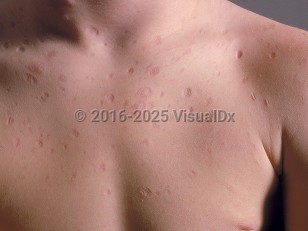Atrophoderma in Adult
Alerts and Notices
Important News & Links
Synopsis

Atrophoderma, also known as atrophoderma of Pasini and Pierini (APP) or idiopathic APP (IAPP), is a form of dermal atrophy characterized by oval, round, or irregularly shaped, brown to gray, smooth, atrophic, depressed plaques with well-demarcated, sharply sloping borders. This distinctive sloping border is often described as a "cliff-drop" border, usually 2-8 mm deep, forming an inverted plateau. Individual lesions range in size from a few millimeters to several centimeters but may coalesce to form larger plaques that measure greater than 20 cm in diameter. The color change may contribute to an optical illusion that accentuates the depression.
Lesions occur most often on the trunk, most commonly the lumbosacral region of the back. Initially, lesions are localized, then progress to involve other areas over months to years before stabilizing. Unlike morphea, atrophoderma is not thought to have an inflammatory stage and is asymptomatic.
The condition occurs disproportionately in females, usually in the second and third decades. However, it has been reported in infancy and old age.
Whether atrophoderma is a nonsclerotic, atrophic variant of morphea or a distinct entity is debated. The etiology is unknown, although it has been theorized that cells with an aberrant T-cell phenotype may be the cause of collagen fiber destruction. The role of Borrelia burgdorferi in the pathogenesis of this entity is highly controversial.
Linear atrophoderma of Moulin is a related condition that follows the lines of Blaschko. It typically develops in childhood or adolescence.
Lesions occur most often on the trunk, most commonly the lumbosacral region of the back. Initially, lesions are localized, then progress to involve other areas over months to years before stabilizing. Unlike morphea, atrophoderma is not thought to have an inflammatory stage and is asymptomatic.
The condition occurs disproportionately in females, usually in the second and third decades. However, it has been reported in infancy and old age.
Whether atrophoderma is a nonsclerotic, atrophic variant of morphea or a distinct entity is debated. The etiology is unknown, although it has been theorized that cells with an aberrant T-cell phenotype may be the cause of collagen fiber destruction. The role of Borrelia burgdorferi in the pathogenesis of this entity is highly controversial.
Linear atrophoderma of Moulin is a related condition that follows the lines of Blaschko. It typically develops in childhood or adolescence.
Codes
ICD10CM:
L90.3 – Atrophoderma of Pasini and Pierini
SNOMEDCT:
711524008 – Idiopathic atrophoderma of Pasini and Pierini
L90.3 – Atrophoderma of Pasini and Pierini
SNOMEDCT:
711524008 – Idiopathic atrophoderma of Pasini and Pierini
Look For
Subscription Required
Diagnostic Pearls
Subscription Required
Differential Diagnosis & Pitfalls

To perform a comparison, select diagnoses from the classic differential
Subscription Required
Best Tests
Subscription Required
Management Pearls
Subscription Required
Therapy
Subscription Required
References
Subscription Required
Last Reviewed:05/16/2021
Last Updated:07/26/2021
Last Updated:07/26/2021
Atrophoderma in Adult

